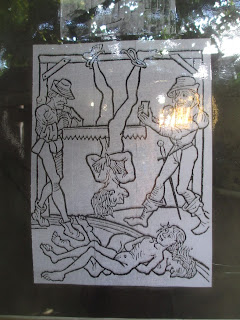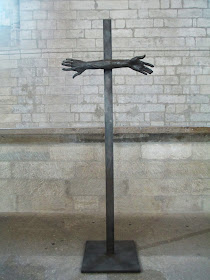 |
| Emotions in Nice, France. |
i think it is a well known reputation of the French that they refuse to speak English, even though they can, just out of spite. In fact, there's a joke that's well traveled among those of us working in European tourism that, though the French are maybe not meant to be the main butt of it, depicts this reputation well:
If you go to Germany and ask someone, "Do you speak English?," they will say, "Yes," and then they will speak to you in English.
If you go to France and ask someone, "Do you speak English?," they will say, "No," and then they will speak to you in English
If you go to Italy and ask someone, "Do you speak English?," they will say, "Yes, yes, no problem," but they will not understand a word you are saying.
And my experience is that all three parts are actually accurate, to some extent at least.
But my work brings me to France quite often and i have found there is more to this French resistance than first meets the ear.
For the most part, in the major touristy areas where i work most often (Paris and the French Riviera), most service providers speak English well enough to make both vacation and working there comfortable. As in most European countries, i find though that some people, and some groups of people (namely private bus drivers), often don't speak any English at all. And that is fine and somewhat understandable. But then this happened:
Arriving to a Paris hotel with a group of Americans, i found the Reception staff was able to tell me all the information i needed (room numbers, how to put the little key-card into the slot to keep the electricity working, bar hours, etc.) and answer all of my questions (time of dinner and breakfast, where ATMs are, etc.). Then, to have some chat, i asked one of the guys working there something like, "How's the season been going this year?" He asked me to repeat myself and i did. Then he said, "I'm sorry, I don't speak English."
At first i thought, "Oh my god, this proves it! i know he DOES speak English, but he is refusing to!!!"
Then, on calmer reflection, i realized the legitimate possibility that what i'd heard from so far may be all the English he knows. Someone who interests themselves in basic competency at their job would, i think, learn how to say the always-used-phrases of their job in the most-common language of their clients.
This brought to mind both the joke here above and the angry thoughts that accompany the reputation that the French can speak English but refuse to. And then, from way back in my college days came the following memory:
 |
| Michel Rocard, former Prime Minister of France. Image from Wikimedia Commons. |
Former Prime Minister of France Michel Rocard was speaking at my alma mater, The American University, in Washington, D.C. He was there to speak about the importance of limiting the availability of small arms in the world. The crowd was mostly Ambassadors and professors. At a certain point in his speech he made a long pause, and we watched as he thumbed through his several pages of notes. Then, eyes down on his notes, he said, "Some people say the French are arrogant....." and then he kept going through his papers without looking up for a beat. Then he made a big smile and, head down, turned his eyes up towards up, and the crowd erupted with laughter.
It was a great deadpan delivery of a truth that was hilarious to hear purely because of who it was coming from. And now in my mind it was reflecting on that Paris reception worker - he was too arrogant to speak a language poorly, as many of us would be, and so said, "I don't speak English," fully believing it.
He was, and they are, i realized, embarrassed to not speak English better. And so they avoid that legitimately uncomfortable situation by saying, "I'm sorry, I don't speak English."
This was later confirmed in Nice at another hotel when when of my teen aged, American clients went to reception and said, in TV-induced valley girl speed-read accent, "Can I have another towel because they room doesn't have enough and we want more." Now, i thought it would have been reasonable for even a pre-internet age adult from her own country to not be able to understand that verbal explosion. The French receptionist blushed hard and shook her head. So the American repeated herself and the receptionist, red as a granny apple said, "I'm sorry, I don't understand." And i heard and understood real embarrassment in her voice as she spoke. And i began to understand:
This nice little French receptionist had been studying English, and had in fact reached professional competence in that language, just as the one in Paris had. And now this sitcom-like American girl was asking her a question she didn't understand at all, and she was embarrassed.
So i blame the French reputation for refusing to speak English on a bad combination of gaining professional competence (unlike the Italians) without the Germanic-language ease of the Germans, plus their own particular brand of high-self-expectations or arrogance.
And then i realized this is more understandable to us Americans than we probably realized.
i was recently looking through my Facebook wall when i found this:
 |
| American flag and French flag together, Normandy, France. |
My friend Devon, who is quite a world traveller and actually speaks passable French, was venting about Spanish in way resembling the French attitude! And i found out it's not just him with this very same thought, there's a little Facebook group complaining about having to push 1. And plenty of other bloggers and writers have made the same complaint.
And that's when i realize: The French are just like us (Americans), except that they actually tend to learn some other languages when they work with foreigners. :-)
All photos by author unless otherwise noted.














.jpg)



















